#hi memmy :3
Explore tagged Tumblr posts
Note
who is it? itssssssssssssssssssssss metal pipe!

be careful... i think shes shy
OMG METAL PIPE HIIIIIIIIIIIIIIII!!!
3 notes
·
View notes
Text
Todays rip: 04/04/2024
Mario Does Not Dream of Bunny Girl Princess
Season 5 Featured on: SiIvaGunner's Highest Quality Rips: Volume C
Ripped by Jiko Music (@jikomusic)
youtube
Requested by Memmy! (Discord)
Well, would you look at that: It's a rip request six months in the making!! I hope the wait will have been worth it, Memmy! And thank you endlessly for championing the blog so early on in its life <3.
Now - I recently spilled a lot of words regarding SiIvaGunner's fifth annual April Fools event back with Your Best Nightmario and Bowser's Finale, just four days ago. It is arguably one of the channel's all-time high points, an event that I still see discussed from time to time by random internet dwellers, even now three years later. And its clear to see why: akin to something like Mega Man Dropping January 7th‼️from earlier this year with Hella Pummel, Mario's "Death" on March 31st was an event that a huge part of the internet was already keenly aware of, one we'd all been anticipating, and one that SiIvaGunner in turn had a golden opportunity to leverage for an amazing channel event. From March 31st to April 3rd, we got to see Mario's existence as a figment be celebrated for one final day, then be entirely erased from the SiIvaGunner channel's reality at the day's end, only to then begin fighting tooth-and-nail in Your Best Nightmario for his memory to live on - a battle that, through our continued support as YouTube commenters, he was able to win in Bowser's Finale. A storybook journey, a clear beginning/middle/end structure, with a clearly-told message by the end of it all - Super Mario was back.
Yet, it still wouldn't be complete without that one last touch. Any book needs a back cover, any film its credits roll, any game a return to the title screen. Mario Does Not Dream of Bunny Girl Princess, then, was what truly closed the whole event out - and in typical SiIvaGunner fashion, did so in a deviously clever manner.
A lot of the appeal in this event as a whole, I feel, is just how easily understood the bit was at a moment's glance. Without even clicking on the videos, a viewer will notice Mario's gone, it's IMMEDIATELY apparent that something is wrong - and that likely drew a lot of eyes to the event that may have otherwise missed it. This shift in dynamics with how viewers engage with the SiIvaGunner channel is practically what this year's April Fools event, from just a few days ago, was entirely built on, yet there it was done in an incredibly tounge-and-cheek way. Because really, what it pretends to be doing almost goes against everything the channel is meant to be! The bait-and-switch, though not nearly as effective as it once was back in Season 1 with rips like Be Cool, Be Wild, and Be My Girl, IS core to what the SiIvaGunner channel is all about. It has always been a channel all about surprising you with something delightful, be that with surprise bangers like Beyond the Floating Isles, hilariously executed bits like THIS RIP WAS MADE BY TEETH GANG, or everything inbetween. There's a reason why I said that this year's event only *pretends* to be going against this - because the bit with this year's overly-explained, corny titles, is that the rips themselves still hold a secret bait-and-switch bit within them. Even when it appears to be quite literally explaining the joke, the channel hides further layers to rips just out of sight.
But what does all of that have to do with Mario Does Not Dream of Bunny Girl Princess? Well, what I'm trying to say isn't that the Season 5 April Fools day event betrayed the essence of SiIvaGunner or anything - rather, that by intentionally breaking its own rules for an entire day's worth of uploads, rules it had otherwise kept up for five whole years prior, it made this sudden subversion and the stakes of the event hit all the harder. That part may be rather obvious, sure, yet the brilliant thing here is that as a closer to the event, Mario Does Not Dream of Bunny Girl Princess employs the exact same trick in reverse order. Because after an entire day's worth of rips going against the grain, a storyline clear as crystal to follow no matter what rip you've landed on - the LAST thing anyone would've expected would be for it to close with something so seemingly low-key, standard-fare, outright NORMAL for the SiIvaGunner channel, as a single rip of Super Mario 64's Staff Roll theme. I'm sure many were expecting a grand fusion collab, some sort of CCC-esque lore video, a true mind-blowing celebration of the journey's end...and yet, to me, this return to normalcy is absolutely brilliant in so many ways, both as a subversion of those expectations, but on so many layers yet deeper. Yes, it marks the return to the SiIvaGunner status quo, it marks that Super Mario has finally been remembered - yet look beyond that, and you may just realize that Mario Does Not Dream of Bunny Girl Princess's one joke subtly hides layers of meaning, that almost recontexualize the entire event.
But, alright, let's get the ground rules set first - Mario Does Not Dream of Bunny Girl Princess is an absolutely lovely rip as is in isolation. Jiko Music is no stranger to the channel nor to the blog, having worked on several hidden-gem favorites of mine such as Trail on Powdery Snow Halation and YACKER TOILET - they very clearly know their way around a rip, and have a stellar track record over their seven years of activity. Super Mario 64's Staff Roll theme is a lovely piece of music already, one I covered a fair bit already with Staff Roll (SM64) Fusion, and Jiko Music absolutely leverages that quality to full effect here - its nostalgic percussion, melody, and instruments that sound so indescribably "Nintendo 64" push this arrangement to some truly excellent emotional heights. The original song's vocals are no longer here, akin to rips like Blessing the Dire, Dire Rains - yet through changing the lead melody's instrument from section to section, from verse to chorus, Mario Does Not Dream of Bunny Girl Princess is able to elegantly replicate how the original song's vocals would change per how many of its six vocalists were singing at any one time. It's a great rip!! ...but wait, what exactly IS the original song its arranging?
Alright, here we go - Fukashigi No Carte is the ending theme to the anime series "Rascal Does Not Dream of Bunny Girl Senpai", a story about many things, yet primarily about a mysterious girl suddenly made invisible to the world around her, dressed in the titular "bunny girl" costume. The immediate surface-level box to tick is, of course, that it's the ending theme to an anime, a credits roll to match the dramatic storyline of the event - but you may also start connecting some other dots, too, hm? Mai Sakurajima, the titular bunny girl, isn't merely made invisible to the world - she is FORGOTTEN by the public consciousness, her existence at all erased from all's mind, save for the series' protagonist who works to get the rest of the world to acknowledge her existence. Sakurajima's curse in the series is, effectively, that of a forgotten Figment - the fate that befell Mario in this very event, with us as the audience taking the role of the story's protagonist, together helping Mario win the fight against his fate by collectively remembering him.
That's a great reference all on its own, but there's another part left to discuss - the coolest part, I'd argue! Unlike comparable events such as Season 7's with ...of 2023, the Season 5 April Fools event spanned a total of five days - from the day Mario's execution was scheduled on the 31st, to April 1st itself when the event of his disappearance kicked into gear, a day-long break of April 2nd leaving his fate uncertain, the final push to resurrection on April 3rd, and the credits rolling on April 4th - which, during 2021 in particular, just so happened to be Easter. And do you notice anything in particular about this timeline of events? Executed on the 31st of March, brought back from the brink on April 3rd: Mario, just like Jesus Christ himself, AROSE ON THE THIRD DAY. Almost through sheer luck, the holiday celebrating the resurrection of Jesus Christ fell *right* next to Mario's great story of returning from public execution - allowing the whole event to come to a close on the most perfect day imaginable. And aside from Jesus himself, what is THE thing that defines Easter as a holiday?
That's right - The Easter Bunny. Bunnies. Rascal Does Not Dream of Bunny Girl Senpai.
The way every single puzzle piece clicked into place for Mario Does Not Dream of Bunny Girl Princess to work is genuinely incredible and some of the coolest shit I've ever seen the channel pull off. Not only is the rip itself a beautiful listen, it nails the landing on every single imaginable front: Subverting the expectations of the entire event's premise by its return to the status quo of rips, connecting the very lore that the SiIvaGunner channel is built on to an anime series with a rather iconic and recognizable ending theme - and connecting the event's storyline to the very foundation of the Easter holiday, and one of the Bible's most well-known events. On the very last video of the event's runtime, Mario Does Not Dream of Bunny Girl Princess made SUPER FUCKING MARIO into a Jesus allegory within the SiIvaGunner channel - and if that's the case, does that make Grand Dad the holy spirit? Is SiIvaGunner ITSELF a loose allegory for Christianity?!
...Mamma Mia, this post got long. But I hope you've been able to understand why I have so many words to say on it - so many thoughts finally able to spill over in the three years I've spent ruminating on this incredible event. Mario's return itself after Bowser's Finale was already pitch-perfect, featuring a sudden reappearance of The Reboot from Season 1 (don't get me started, I'll be here all day) - but ending it all off with something so seemingly plain, yet hiding so many layers of beauty and connective tissue, as Mario Does Not Dream of Bunny Girl Princess...it, to this day, blows me away how perfectly the pieces clicked into place.
#todays siivagunner#season 5#siivagunner#siiva#Jiko Music#Youtube#Bandcamp#super mario#super mario 64#mario 64#sm64#rascal does not dream of bunny girl senpai#rascal does not dream of a knapsack kid#rascal does not dream of logical witch#rascal does not dream#mario games#super mario 3d all stars#super mario sunshine#anime ending#anime music#anime opening#anime#easter
24 notes
·
View notes
Note
Gimme them Memory headcanons! Please!
Say less! o7
>headcanons under the more/reading<
(Sorry it's long & for late response, was shopping for birthday stuff)
First 1: Memory in my design has white streaks they got from Void's side! Void just dyes his hair black to hide em for unknown reasons (probably ego or smth I dunno. Voids out of my control /j)
2: They're 6'4, uses mostly It/They but also uses he. They prefer mostly the other two tho but won't get mad if he is also used. (This one's mostly based off how in canon, Memory was referred to as a thing by Sabre, and he would use It/They until switching to He. Mem was still called a thing but used he ig). Oh and ig they also used nicknamed but only like it when Void calls em them. Like Memmy/Mem/Memoy/Fancy Steve lol
3: He has light sensitivity and uses their mask to help it when outside of the void/memory dimension
4: It has heterochromia, but in a different way! His left eye doesn't have a iris/pupil, and the area that's supposed to be white is pure red like Voids. (I think it's called the sclera) and also on said left side, they have a scar on its cheek that it got during some event they doesn't like talking about
5: Memmy likes cats and owns two! One tuxedo cat named Voodoo, and the other, a black cat (Bombay I think) called Morticia! Memmys had them since they was a smol lil swirly peppermint boi, and treats them like royalty as deserved 😤
6: (this one's kinda from a quote my friend made but it's too funny to not make a Memory headcanon) If Memory got called a specific slur I'm not gonna say, he'd just be like "Yeah no duh, it's obvious. Now please tell me something I already don't know about myself, or leave please and thanks."
7: Memory is highly skilled in swordsman ship, archery, and fighting. It's won awards in competitions they entered secretly (not because Void would be mad, but because they're Void's son. Void's like a king/God in the eyes of the other steves [of course except Nightmare LMAO] and terrifies em.) They's only lost once and that was more on its end since he didn't want to do competitions anymore, so they purposely disqualified itself by starting a fight.
8: while this one may be more of a ship that was started for funnies, it took my brain over so uh yeah. Memory is married to Faceless. The reason for why (to me) is because since Faceless doesn't have a face (no duh), he's immune to Memory's powers, even when mimicking others. And Faceless just couldn't resist a fancy boi in a suit. (I love this ship but at the same time I'm like "I want it gone from my mind its been 3 months help") ik they never met canonically but I speculate they met a tiny bit when Elemental worked for Void and El had to capture Faceless. It's a long shot but yolo I was bored
9: Memmy boi like flowers. Mostly roses or any black flower, but they'll be content with any other color if red & black are unavailable :)
10: While Memory may seem stern and cold, when you get to know them, he's really nice! Though it's usually always on guard and will unintentionally break your arm if you happen to spook them (somehow).
11: Memmys very sneaky and will smile a cheeky smile when it scares someone from behind.
12: Memory really hates cameras. Like, REALLY REALLY hates em. Whether it's off or not, they don't care and WILL throw a dagger at it. This one's more from a funny thing Sabre himself replied with in his discord when I said "I wish Memory had more screen time. He would of bee such a cool villain" with Sabre replying "maybe he did but we forgot".....I walked basically right into that joke but I love it so I'm considering it canon /hj
Uhhhh yeah anyways I think that's it other than more funny meme ones me and a friend made when I was bored and thought 'what if after the camera was off, Sabre and the steves would have a smp world together' and Memory would be the sometimes chaotic one of the server.
Ye uh I rambled alot lmao idk if this will even post but thank you so much for the ask and willingness to hear the headcanons about our silly little peppermint boi! Memory deserves so much more love that what's seen, I love him so much
Memory Steve, our beloved 'forgotten' king <3 👑
18 notes
·
View notes
Note
🤝 since you know my type, apparently 😔

:3 for you, Memmy, I chose Trey Clover from T.wisted W.onderland. He's the big brother of his dorm, the vice housewarden and keeps their dorm leader reigned in. Sorta. He's helpful, but not necessarily because he's generous; he helps people to keep things laid back, he won't unnecessarily offer anything to others; he also plays pranks like telling the new dorm members he uses oyster sauce in a pastry, plus he bakes he's a housewife dude, lmao
3 notes
·
View notes
Text

Striking Roots
Joe Turpin
Lusaka Contemporary Art Centre
August 23 – August 30 2024
“That they could “contribute to the development of liberation movements” and “…earn a civic and national status other than that of colonizer, eternal outsider.” The “foreign” plants might mutate and strike roots.”[1] – Nadine Gordimer
This quote by the late South African writer and Nobel Laureate Nadine Gordimer refers to those white, mainly Jewish, South Africans who joined the anti-apartheid struggle in South Africa. Such a metaphor also applies to Simon Zukas, who was one of the few white people to join Zambia’s liberation campaign and fight against British colonisation and white settler federation. Many of these brave people paid with their extensive time in prison, in exile, and even with their lives, for a cause greater than their own. These political figures and their actions form the point of departure to Joe Turpin’s research and multidisciplinary art practice, informed by the anti-colonial position in Africa, both past and contemporary. Is there a white position in fighting colonialism, and furthermore, is there a an anti-colonial Jewish position as well? How have such figures, who have demonstrated this radical empathy with the colonized masses in our recent histories, been memorialised? These questions pose the thematic concerns that Turpin has grappled with during his residency with Lusaka Contemporary Art Centre.
Striking Roots is the culmination of this work, and is presented as a multi-disciplinary exhibition comprising of paintings, drawings, video, sculpture, performance and installation, which address the aforementioned political and historical wanderings in a visual representation, that ultimately seeks to determine a greater understanding of Turpin’s own identity, and sense of belonging on the African continent.
Joe Turpin (b.1995 in Johannesburg) is a South African visual artist whose research practice focuses on historically charged narratives and semiotics as expansions of painting. Joe makes mixed-media installations grounded in painting that create temporal conversations about identity, memory, and history. His Jewish heritage becomes principal and consequential in exploring stories of migration and persecution. These cultural paradigms inform his archival research and artistic production.
Turpin holds an MFA from the Pratt Institute in New York (2023) and BA in Fine Art from the University of the Witwatersrand in Johannesburg. Joe Turpin was a Top 3 finalist in the 2019 Cassirer Welz Award and a 2022 recipient of the Stutzman Foundation First Year MFA Fine Arts Awards for Three-Dimensional Art. He lives and works in Johannesburg, South Africa.
[1]Nadine Gordimer from Albert Memmi, The Colonizer and the Colonized (London: Profile Books, 2003), 37-38.




#art#joe turpin#painting#artist#installation#turpin#contemporary art#lusaka#zambia#contemporary#exhibition
0 notes
Text
Drawtectives Season 2 Finale Live Reaction
Holepunch dude....
....it's a helmet?
OMG
it's....it's....a cat?
Felix
His name is Felix and he belongs to Eugene
Oooohhh, a catamotronic
Eugene's remembering
Nooo, his cat died
......I
...I'm confused but...okay?
Ooohh, nice fit Felix
"It's me, grandmama, Felix!"
I'm still lost about this but like okay, I dig this
"Why did you make him tall?"
"Why did you make him kinda hot?"
I love you Rosé, never change
A cat with a job, my favorite kinda cat
OMFG
OF FUCKING COURSE THEY WOULD MAKE A CATS 2019 REFERENCE.
"Didn't you kill him?"
Oh, conductor dude was knocked out.
"I'm a cat with a job" OωO
Go to Eugene's office!!
Felix is so cuuute 🥺🥺🥺
Ooohh
Zoom in on those posters
Ripped....poster....sus
"Rosé read it to me."
Eugene's notes are super cute
......
Oh no
Oh noooo
:0
Spirit VR shit
Binception
Harvey, a man of many talents. Juggler, high flyer and hot dog eater.
Young Terry!!!
"Look for cat"
The cat is a criminal
Junary 2nd
Smarch, Mabril, Bachtober
Tall for both weather purposes and viewing purposes
Hahahahahaha omg, the pinching
Aaaaaww Felix
Premier chat: among us
Everyone is a spirit???
Premier chat: death ™
"No brain, full of memmies"
Taken by surprise....
Hmmmm....
York reflex: pissing on people who surprise him
A DECOY?!
OMG THERE IS A DIFFERENCE
......so, they are in space?
Rosé asking if she should steal is fucking hilarious
York: IT WAS JOE BEANS!!!…
Man, y'all, I fucking ADORE Felix
....new ship....Jancy x Joe. Truebeans.
"I'm also not very observant" Mood
Conrad....or ConBAD???
omg the hall again
I love the attempts at opening the door
5 idiots and Jancy
I was about to say "5?" but then I remembered: oh yeah, Eugene and Felix are dumbasses (affectionately) too
DISSOLVED SPIRITS?!
FUCK OFF "CONRAD" WHAT THE FUCK
"It's my train now" you son of a fucking bitch, I will end you.
Premier chat: ARM JAIL
"We're your dad"
Who are you Conrad Octur
You know what, I don't care, you're a BITCH, that's what you are!!!
"No one's interested in hypnotism; no one wants to see my shows-" No, no one wants to see a dick, which is what you are "Conrad Octur"
Angry Grandma
Go off Grandma
Go off Drawtectives, fuck him up
"It doesn't matter, they're dead. It doesn't matter to me."
FUCK YOU "CONRAD OCTUR"
Fuck you "Conrad" you used Felix >;(
FELIX JUST WANTED TO BE HELPFUL YOU FUCKING "IT DOESN'T MATTER IF THEY'RE DEAD" PIECE OF SHIT
Horrific death slime
SHUT UP!!
SHUT UP SHUT UP SHUT UP!!!
"Me me me me, I did it ALL" bitch, fuck off
SOUP SOUP SOUP
DUNK THE SON OF A BITCH
Haaaaa >:)
Eugene!!! :D
Shut up "Conrad"
Bye Felix
Is this the real life? Or is this fantasy???
"Is there any soup?"
Eugene... 🥺🥺🥺
HUCK E HEESE?!?!?
FUCK YEAH LET'S GOOOOO
Heeeeeyyy, Jancy
YAAAAAAAAYYY HUCK E HEESE!!!
Aaaaaaahhh
It's over
It's done
I'm crying
Aaaaaaaaaaaaaaahhhh
The fucking end credits
Possible Season 3???
omg please please please
YEAAAHHH!!!
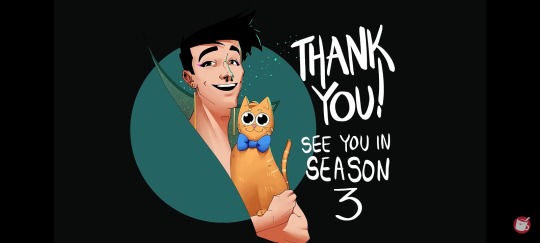
41 notes
·
View notes
Photo

MWW Artwork of the Day (12/23/21) Simone Martini (Sienese, 1285–1344) Detail: Annunciation (1333) Tempera on wood Galleria degli Uffizi, Florence
The altarpiece was executed between 1329 and 1333 for the chapel of Sant'Ansano of the Cathedral in Siena by Simone Martini and his brother-in-law Lippo Memmi, to whom are attributed the two lateral figures: Saint Ansano -- patron of Siena -- and Saint Giulitta. On the gold background the figures of Angel Gabriel and the Virgin enhances Gothic line, without narrative details: just the central pot with lilies, symbolizing Mary's purity, and the olive branch. The golden relief inscription starting from the Angel's mouth contains beginning words of the Annunciation.
For more of this artist's work, see this MWW gallery/album: https://www.facebook.com/media/set/?set=a.458364304268944&type=3
48 notes
·
View notes
Note
Sniblings personalities?
Snibling 1 - Memara (Memmie)
Memara is the oldest of the sniblings, being the Monster equivalent of 12. She's fairly soft-spoken normally, often finding herself unable to speak up for herself. However, when her friends or sniblings are involved, she becomes the loudest and most outspoken child you've ever met until her friend or snibling gets what they need. Ingo had a fairly difficult time gaining her trust, but he eventually won her over by happily listening to her infodump about her interests and genuinely paying attention to what she had to say.
Snibling 2 - Surxis (Surs)
Surxis is the second oldest and rowdy by nature. He often spends his time running around trying to burn off excess energy, occasionally causing trouble but fully prepared and willing to take the blame for the trouble some of his younger sniblings cause. He started liking Ingo pretty quickly, but he started thinking of him as family when they had their first friendly argument over who would take the blame for something neither of them did. Ingo won. Lady Sneasler did not believe him. On a side note, Ingo is the reason why Surxis was able to discover his love for singing.
Sniblings 3 and 4 - Tellid and Anyde (Tellie and Anai)
Tellid and Anyde are twins, and the biggest troublemakers you will ever meet. They pull pranks on almost everyone they meet, and almost never get caught since they're more than happy to dump the blame on their older brother Surxis. The two of them (nb and girl) are the most likely to jump onto anyone bigger than them to use as a very suddenly impromptu jungle gym until they get bored. The two of them have even gotten themselves banned from almost everywhere in Snowdin, and have been planning on making that absolutely everywhere in Snowdin, and next, Waterfall. They most definitely took a while to fully trust Ingo despite immediately jumping on board with the whole "yeah he's been our brother the entire time" thing just to fuck with people. However, Ingo eventually won them over to a point where they will actually behave around him, a feat of which even Lady Sneasler has been unable to achieve.
Snibling 5 - Pipilin (Pip)
Pipilin is the youngest snibling, being around the monster equivalent of a toddler. They are very playful, but very much unaware of the fact that sharp things hurt people. Thankfully at this point their teeth and claws aren't as sharp as they could be, but I'd be lying if I didn't say they were the main cause of most of Ingo's poison sick days. They are very giggly, though they haven't quite figured out how to smile yet. Once they're older by the time Frisk would fall, they are still very cheerful but still has not figured out how smiling works. Thankfully, their oldest brother Ingo is able to provide support by showing that even someone as cool as him has trouble with making smiling work. They got along swimmingly with Ingo from the beginning. They love Ingo very much.
#ns:tu#next stop: the underground#pokemon#undertale#pokemon x undertale au#sniblings#pokemon ingo#thanks to Ingo's help and praise all of them are going places#Memara will be continuing the family name as the oldest daughter#Ingo will give her the strength to lead the family when the time comes#the twins are gonna freak so bad (positively) when they find out about Emmet I'm so excited
10 notes
·
View notes
Text
Pointless War in Howl’s Moving Castle
How Miyazaki Renegotiates Imperialist Assumptions By Kelsey Roberts When the 75th Academy Award for Best Animated Feature was declared to be Hayao Miyazaki’s Spirited Away, the room erupted into enthusiastic applause for the director and his passionate team at Studio Ghibli. However, neither Miyazaki nor any of his employees stepped forward to receive the award. In fact, his presence, or lack thereof, was quickly and conspicuously glossed over by the Award announcer, Cameron Diaz, who accepted the award on behalf of the Academy before the show continued on. That Miyazaki would miss an invitation to his first nomination, and only win, at the Academy Awards was indicative of something much more powerful than recognition for the arts. Two years prior, on September 20th, 2001, United States President George W. Bush addressed the nation after the attacks on the World Trade Center in New York City. In his impassioned speech, Bush declared that any forces opposed to the United States and their War on Terror, were choosing to side with terrorism. With lines clearly drawn in the sand, Hayao Miyazaki stood back and said “no” to making any decision at all. In fact, he made it very clear on several occasions that he would not visit a country that was dropping bombs on another. At the time of the 75th Academy Awards and the success of his movie Spirited Away, Miyazaki remained resolutely in Japan, working on an emphatically pacifist cinematic reply to the ultimatums presented by the world’s most boisterous military presence.
English poet and novelist Diana Wynne Jones published Howl’s Moving Castle, the first novel in a series of magical children’s books, in April of 1986. The plot centers around a young woman named Sophie Hatter and her dealings with the eponymous Howl Jenkins, a womanizing wizard who travels through time and space via a magically “moving” castle. Ingary, the fictional country in which the story takes place, is full of magic and fairytales, supplying a handy backdrop for deeper questions the character’s face throughout the story. Does a character’s agency matter if fairytales are true and magic supplies near limitless power to some and not others? Sophie, believing a fairytale assumption that she has nothing to achieve other than quiet spinsterhood, resigns herself to this fate, just before being dumped headfirst into an epic romance featuring curses, witches, and kings. Howl, with the might of magic on his side and no earthly consequence to face in result of his endless agency and selfishness, realizes the impressive force of responsibility, though only when it comes to the people in his care. He willingly chooses to lessen his own agency to protect and provide for Sophie and his family. The end finds them reaching an equilibrium of agency and responsibility, of destiny and magic, to live happily in their mystical country. Unfortunately, Wynne Jones’ novel remained unawarded during the original print of the novel, and faded quietly to the shelves of children’s libraries until Japanese animator Hayao Miyazaki happened to read it while visiting Strasbourg, France.
Struck by the magical environment of Ingary (no doubt flavored by his recent trip to Strasbourg) and the question of just how a magical castle would move, Miyazaki quickly had Studio Ghibli purchase rights to a feature length film. In 2001, the studio announced that it had begun production of the film with Miyazaki at the helm as director and featuring a musical score created by the equally prolific Joe Hisaishi. Entranced by Wynne Jones’ descriptions of Ingary, Miyazaki chose to return to France, this time to Alsace, to study both architecture and surrounding natural settings to use in his storyboards. The film’s castle designs, and by extension all representations of both technology and magic throughout, were heavily inspired by the French artist and novelist Albert Robida. Robida, a futurist who died in the 1920s, envisioned future technology to be integrated more fully into the everyday, rather than the notions of mad-scientists and scientific abominations that were more popular with his peers. This naturally absorbing technology is reflected in the aliveness of Miyazaki’s interpretation of the moving castle and the visual incorporation of Industrial-era technologies into the practice of Ingarian magic. After spending 3 years in production, and consisting of approximately 1400 storyboards, Howl’s Moving Castle was released to Japanese audiences on November 20th, 2004vi. The film was distributed by Toho in Japan before being dubbed into English by the Walt Disney Company for release in the United States on June 10th, 2005. Howl’s Moving Castle was nominated for Best Animated Film at the 78th Academy Awards and as of 2020, it stands as the fifth most successful film released by the country of Japan.
Methods
By choosing to create a film to critique the war practices of the United States of America, Miyazaki is likewise critiquing the ideologies that lead nations like the United States to interfere politically, economically, and militarily in other countries. These ideologies, also called hegemonic structures, work to perpetuate themselves in the minds of the privileged that enact these ideologies upon the oppressed. In an effort to define the differences between those privileged by Western ideology and those oppressed under it, Albert Memmi suggests that he doubts that an entitled citizen’s “gullibility can rest on a complete illusion.” In other words, those that privilege from Western ideologies are at some level aware of this inequality and choose to deny its existence to preserve their own benefits. While the recent actions of the United States military, including the invasion of the country of Iraq, have been analyzed and critiqued politically, there have been few direct consequences to those that directed the military. In fact, military expenditure in the United States is still the highest of any country in the world. Only by directly confronting the concept of war, without valorizing or propagandizing the actions and reactions of countries or ideologies, can violent hegemonies be broken down and effective discussion can truly begin.
The strength of these hegemonies is aided by the continuous circulation of information and media that reinforces them. Western education and Western art, including cinema, reinforce the economic, moral, political, and militaristic dominance of the Western culture. One of the only ways to actively combat these hegemonic mediascapes is to produce and analyze media from outside Western structures of thought. Ella Shohat and Robert Stam call this active combat “multiculturalism” in their book on Unthinking Eurocentrism. Eurocentrism, this continuous domination of Western ideology, “sanitizes Western history while patronizing and even demonizing the non-West.” By choosing to represent Western cultures as the only morally correct and only forward moving culture, while systematically infantilizing other cultures and ideologies as “developing,” Western education and media pick and choose exactly what histories and lessons deserve legitimacy and which do not. Hayao Miyazaki was born in Tokyo in 1941 to a father that manufactured parts for Japanese imperial fighter planes. By the time he was four years old, he had been evacuated from three different homes and had witnessed the fire-bombing of his country. As such, Miyazaki has a significant perspective about Western notions of war, having experienced both sides of an imperialist military force. Imperial Japan provided his father with a job and his family with protection, until United States militarism tore through his home, his family, and his national identity. Eurocentrism, particularly the valorization of the United States’ Pacific campaign during World War II, would not allow for Miyazaki’s unique perspective on imperialist war practices to be critically disseminated. Shohat and Stam’s call for multiculturalism as the solution opens the door for Hayao Miyazaki to provide many varied filmic representations of his unique perspective of both Japanese and United States imperialist hegemonies.
Hayao Miyazaki, in looking to discuss these significant concepts from a safely fictional distance, actively confronts both his own Japanese cultural identity, and the individual identity of the spectator. The encouragement of this feedback loop of dialogue is reminiscent to Stuart Hall’s considerations of cultural identity in his essay, Cultural Identity and Cinematic Representation. Singularly important to Hall’s analysis of cinematic representation is a duality of identity that could be similarly identified as a feedback loop. First of these cultural identities is the concept of a “shared culture, a collective ‘one true self,’ hiding inside the many other...selves.” This shared culture is rooted deeply into common experiences and social codes that allow society to continue functioning with relative stability. The discovery and expression of this deepest cultural identity is attributed to powerful creative and representative force that allows marginalized peoples and ideas to express themselves outside of the more restrictive hegemonies of cultural identity. The second definition of cultural identity conversely involves strong points of difference and individuality present in each person, which as previously noted, are entirely at the mercy of hegemonic structures looking to reinforce their own supremacy. Hall calls this second definition a “becoming” of identity, that is continuously redefined and negotiated in relation to both recent history and present considerations. Miyazaki, choosing to confront both definitions of cultural identity with his cinema, presents his audiences with the tools to renegotiate their own cultural identities and preconceived notions.
One of the most intense differences between Diana Wynne Jones’ original novel and the filmic adaptation of Howl’s Moving Castle is the narrative inclusion of war. The original novel talks about war only tangentially, with Ingary’s King requesting Howl’s help to find his missing war-general of a son. With impending war relegated to a sub-plot, the bulk of the story focuses on how Sophie and Howl grow closer together through prolonged disagreements and magical shenanigans. The narrative of the novel paints a distinctly Western perspective on the valorization and presumed agency of those involved with war, by choosing instead to focus on a relatively privileged wizard who can shirk responsibility in favor of womanizing and magical travel. Memmi likewise considers a colonizer to be a man of this type: “If he preferred to be blind and deaf to the operation of the whole machinery...; he is then the beneficiary of the entire enterprise.” Ignorance of the harmful constructs of war, using war as a subplot as though there are not direct consequences to war, makes the original plot compliant with hegemonic constructs. Conversely, Hayao Miyazaki’s adaptation of Howl’s Moving Castle drags the war to the forefront of the narrative. Fear of war and death is the motivation for Howl’s selfishness, and the motivation for him to gain responsibility for the safety of Sophie and his country. By bringing war to the forefront of a children’s narrative about assuming responsibility for power and the abuses of those powers, Miyazaki creates an environment to confront the complex duality of his own cultural identity as a Japanese man, and to confront the similar injustices he saw in the United States occupation of Iraq.
Analysis
Hayao Miyazaki is a master of visual shorthand; every shot does as much heavy lifting as possible to assist the audience towards personal connections. From the first second Sophie’s hometown, a village in Ingary, appears on screen the audience is bombarded with militaristic propaganda, including an ever-present national flag. Featuring unfamiliar and highly visible strips of pink and yellow, hardly a shot of Ingarian civilization is shown without one or many Ingarian flags hidden in plain sight. Miyazaki elevates this level of nationalism to uncomfortable levels early on, highlighting his own experiences with imperialism. Soon after we meet Sophie, we witness her pass by a highly detailed grand parade of troops and war tanks. A crowd of civilians cheers the soldiers’ uniforms and perfectly timed goose-stepping, waving Ingarian flags as heavy brass trumpets play something heroic and distinctly European in style. Throughout the film, as the war causes casualties, Sophie overhears civilians casually discussing the lack of motives for the fighting and their superior military technology. In 2004, this kind of patriotism may have seemed familiar to the population of the United States. After the attack on the World Trade Center, Walmart sold approximately 116,000 American flags, and another 250,000 the next day. Nationalism was pouring through the streets of America, and that nationalism looked like stars and stripes. Concurrently, anti-Muslim hate crimes in the United States rose by over 800%, and the Patriot Act was implemented, removing safeguards against government surveillance and seizure. Shocked beyond reason, United States citizens overlooked the stripping of their own rights under the guise of national security and patriotism.
While it is quite clear that Miyazaki recognizes the visual affect that is attached to military performance, he does not hide his distaste for the valorization of war. Everything outside of the Castle seems to be focused exclusively on Ingarian nationalism and wartime propaganda, and yet inside there is a distinct absence of hegemonic structures of any sort. When Sophie first enters the Howl’s abode, she immediately learns several seemly disconcerting things; Howl is a terrible housekeeper, and a sarcastic fire demon pilots the whole Castle. A small child named Markl is left alone to watch Howl’s business aliases while the wizard disappears for days on end. Within a few scenes, Sophie’s previously “predetermined” constructs of home, trust, and family are broken almost beyond repair. Two of these hegemonies just happen to be civic duty and citizenship. Howl elects to keep the Castle moving through the untamed Wastes of Ingary, far from military occupation and government control. Rather than the lawless and desolate wasteland that Sophie first believes, the Wastes prove to be glorious mountainsides and lush green lands, reminiscent of Miyazaki’s travels to France. Though extremely capable of leaving his country entirely, Howl chooses to remain in the countryside of Ingary, removing any reminders of the violent constructs which he does not feel represent the natural beauty of his home. In this way, Miyazaki contrasts two drastically different forms of nationalism. One is focused on the outward enforcing of hegemonic constructs on other countries, and the other is focused on the inward appreciation of the natural resources and beauty that a country can provide its citizens.
Unfortunately, Howl is not able to fully escape his own moral imperative to help people. Though he hides from the draft notice issued by the King of Ingary, Howl travels to the frontline to protect civilian homes from the carnage of battle. Scenes showcasing indiscriminate battleships dropping firebombs punctuate Howl’s interactions with his family, providing a clear connection to his reason for fighting. While in battle he confronts several less powerful wizards that are mutated with magic. Later, Howl comments sadly that these wizards readily turned themselves into monsters under the King’s orders, and as such will never regain their humanity. Throughout the film it is implied that Howl’s dedication to Sophie and to his own personal freedom are the only things that prevent the loss of his own fragile humanity. The emotional and physical cost of war is not limited to either side of the confrontation. All individuals that take part in the structures of violence are affected. Clear connections between these wizards and the soldiers that fought in the War on Terror are made, focusing on their difficulty to return to civilian life and their struggles with the atrocities that they commit. A database called the Iraq Body Count has been working diligently to try to document the countless Iraqi civilians that were killed by the United States invasion. Unfortunately, they are only able to provide a rough estimate of between 185,497 – 208,547 deaths from violence. Miyazaki’s urge for victims of war and soldiers to lean on family and nation while under these stressors, while a bit simple in concept, reflects a lack of compassion shown in Western media for both the civilians of foreign nations and soldiers who do not return proud of their accomplishments in war.
Comparisons could be drawn between Howl’s active pacifism and general Japanese cultural identity post-World War II. After the total annihilation of two of their cities by nuclear bomb, and the death of hundreds of thousands of civilians by firebombing, the Japanese Imperial Government surrendered to the United States on August 15th, 1945. After their country brutalized in the name of imperialism, it was likewise brutalized in the name of Western democracy. Soon after, a constitution was put into place to usher in new political constructs, one of which being the intensely debated Article 9. Within this article is the assertion that the Japanese government will never again have a standing military presence, or more specifically: “Aspiring sincerely to an international peace...the Japanese forever renounce war as a sovereign of the nation.” In choosing to directly confront the ideological structures that preclude war as a part of politics, Japan opens larger conversations about pacifism that Miyazaki makes great narrative use of. Outwardly expressing his opposition to amending Article 9 of the Japanese constitution, Miyazaki emphatically declared that “Japan is not a country where a war can be fought.” Unlike the boisterous, illogical military might continuously pushed into the audiences’ face, Howl exists as a direct example of the Japanese ideal of active pacifism, to actively choose peace in the face of injustice and violence.
The simplest way to illustrate Miyazaki’s own difficult reckoning with his unique cultural identity is in comparing the depiction of technology in the beginning and ending sequences of the film. Howl’s Moving Castle begins as many Miyazaki films do, with an introduction to a main character. However, the main character portrayed in this first shot is neither Sophie Hatter nor Howl Jenkins, but the infamous Moving Castle, stalking its way through a heavy fog in the Ingarian countryside. Direct attention is paid to the lifelike mechanics of the Castle’s movement, the creaking and groaning of enormous gears and bellows of its anthropomorphic “face,” as four spindly chicken legs hold up the incomprehensible weight of the underbelly and spike-like towers. Each mechanical piece, though entirely disparate and featuring a slap-dash sort of connectivity, works together within the whole of the Castle to provide an astounding feat of both the technology and magic that permeate the narrative’s universe. In these first shots, the audience is introduced to the “human technology” favored by Albert Robida; a living, breathing home for the other protagonists, something that audiences can connect to. Technology of this sort is the technology that Miyazaki experienced as a child; watching his father create flying machines that he envisioned as vehicles to adventure. Quickly, as in life, the peace of these beginning shots faces a violent juxtaposition, and in the next sequence spectators watch as the Castle hefts its girth behind a cloud of fog, just as two small military planes bearing Ingary flags pass by.
The final shots of Howl’s Moving Castle, after Sophie has successfully restored Howl’s heart and the family has both actively and passively saved their country from catastrophic destruction, feature a reversal of the initial sequence. Through a thick blanket of thunderhead clouds, a hole reveals enormous and anonymous battleships flying in formation. Their muted sounds and shiny seamless technology, seen throughout the film in direct contrast to the hodge-podge hominess of the Castle, is rendered soulless. None of the life of the Castle is present in the machines of war. For Miyazaki, technology used for the object of violence and death cannot be alive. Instead, the technology is stripped of all liveness, just as the wizards who submit to Madam Sulliman lose their humanity. With the war ended and yet not won, these violent machines are castrated, and their purpose has ended. They disappear, covered by the blanket of darkness that their purpose has covered them in. Then, from behind a curling tuft of cloud emerges the newly restored Castle, into an endless bright blue sky. This third iteration of the Castle, featuring sweeping wings, is no longer tied to the ground. Instead, Howl and Sophie stand romantically at the helm, watching as Calcifer pilots their home towards a brilliantly sunny horizon.xxv While this ending may seem saccharine in comparison to the more realistic ambiguity of the outcomes of war, Miyazaki seems to favor the notion that those who fight for the safety of their country deserve a measure of peace at the end of their service. Whether or not Miyazaki thinks that measure of peace should be afforded to those in control of these soldiers is decidedly less certain.
Conclusion
Hayao Miyazaki’s distinctive personal history, coupled with his complex cultural identity as a Japanese citizen, makes him uniquely determined to speak on matters of pacifism and war. As an animated film director, his medium allows him a certain distance from distinct hegemonic structures and allow him to confront difficult concepts in a gentler fashion. This is not to say that Miyazaki is in any way ambiguous about his intentions. As depicted in Howl’s Moving Castle, Miyazaki uses visual storytelling to paint the country of Ingary to be a fictional mirror of the nationalism present in the United States in the early 2000s. Ingarian flags hang from every building outside of Howl’s sheltered Castle, reminiscent of the patriotic fervor that gripped the citizens of the United States at the beginning of the War on Terror. Howl himself provides the audience with a character that reflects Miyazaki’s own distaste for this sort of brute nationalism, instead choosing to appreciate his country in more passive, classically romantic ways. Soldiers and wizards that brazenly choose to fight for their King are treated with compassion and pity, lamenting their lost humanity, while Howl’s dedication to his family and his country are the only thing that prevent him from meeting a similar fate. With design cues and philosophy borrowed from Albert Robida, Miyazaki crafts clever shorthand to portray technology in both militaristic and humanistic ways, highlighting the liveness and the hominess of humanist technology, and shunning the militaristic technology as sleek but soulless. Doing so provides Miyazaki an outlet to confront his own disconcerting childhood, having spent his youth connecting the technology of adventure to the machines of imperialism. Though his opinions on war, pacifism, and the United States brand of nationalism are overt in this film, Miyazaki as a single director is unable to completely dismantle the hegemonic structures that he critiques. However, Howl’s Moving Castle does provide a thoughtful and methodical meditation, allowing for the beginning of discussions about the ideologies that power the machine of war. Bibliography
Cavallaro, Dani. Hayao Miyazakis World Picture. McFarland & Co., 2015.
Cavallaro, Dani. The Animé Art of Hayao Miyazaki. McFarland & Co., 2006.
Hall, Stuart. “CULTURAL IDENTITY AND CINEMATIC REPRESENTATION.” Framework: The Journal of Cinema and Media, no. 36, 1989, pp. 68–81. JSTOR, www.jstor.org/stable/44111666. Accessed 26 Jan. 2021.
Iraq Body Count, www.iraqbodycount.org/database/.
MacCarthy, Helen. Hayao Miyazaki: Master of Japanese Animation ; Films, Themes, Artistry. Stone Bridge Press, 2010.
Memmi, Albert. The Colonizer and the Colonized: Introd.by Jean-Paul Sartre. Beacon Press, 1972.
“Miyazaki, Hisaishi, and Their Collaboration.” Joe Hisaishi’s Soundtrack for My Neighbor Totoro, 2020, doi:10.5040/9781501345159.0008.
“President Bush Addresses the Nation.” The Washington Post, WP Company, 20 Sept. 2001, www.washingtonpost.com/wp-srv/nation/specials/attacked/transcripts/bushaddress_092001.html.
“The United States Spends More on Defense than the Next 10 Countries Combined.” Peter G. Peterson Foundation, 15 May 2020, www.pgpf.org/blog/2020/05/the-united-states-spends-more-on-defense-than-the-next-10-countries-combined.
Yazbek, Yara. “Miyazaki Hayao's ‘Howl's Moving Castle’: Environmental, War-Related, and Shojo Discourses.”
#miyazaki#hayao miyazaki#howl's moving castle#essay#graduate seminar paper#seminar paper#research#english research#graduate research#film#imperialism#film analysis
41 notes
·
View notes
Text
Mediterranean Medley: The Jewish Community of Tunisia
Tunisia is currently making global headlines. A decade ago the Tunisian protest for democracy sparked the “Arab Spring”, which led to vast political shifts in the Middle East. Now, its citizens are fighting to retain their past achievements and curb the ruler's authoritarian pursuits.
The recent events in this small country on the southern shore of the Mediterranean also provide an opportunity to discuss its Jewish community, a community small in numbers yet incredibly diverse in terms of socio-economic status and cultural orientation. This entry is therefore dedicated to exploring the complex history of the community, including the particularly tragic chapter of the Nazi occupation during the Second World War. As always fiction and culinary elements will be weaved into the discussion.

(Tunisia on the map: between Africa and Europe)
Berber, Italian and French Mix
The Jewish community of Tunisia settled mostly in the coastal areas in the cities of Tunis, Sousse, Sfax, Bizerte and Monastir. There were also several rural Berber communities, in which Jews lived a semi-nomadic life.

(The beautiful coast)
The origin of the Jewish community is disputable. Members of the community claim the first settlers migrated from Jerusalem after the destruction of the second temple in 70 CE. Several scholars, however, ascertain that the community originated from the conversion of either Phoenicians or Berber tribes.
Origin aside, archeologists indicate a viable Jewish presence beginning in the fourth century CE. Evidence also shows connection between Tunisian Jews and Jewries in Persia, Israel and Iraq. The Bagdadi community and its Talmudic centers, in particular, was a source of inspiration fueling the local Torah learning, and overall intellectual life.
In the fifteenth century, Andalusian Jews found refuge in Tunisia while escaping the Spanish Inquisition. Their influence is notable in architecture, culture, and clearly cuisine. Another wave of Jewish immigrants arrived to Tunisia from the Italian port city Livorno during the sixteenth and seventeenth centuries. The Livornese Jews, mostly Portuguse Marrano descendants, built maritime trade between North African hubs to European Mediterranean port cities. In 1741, the Livornese community (also called “Grana”) asked for autonomy on the pretext of having a different liturgy. Followed by this act, two separate communities- native and Livornese- were formed. The two sub-communities had their own rabbis, synagogues, cemeteries and philanthropies. The Livornese section, which actually encompassed all European Jews whether they came from Italy, France, Gibraltar or Malta- prided themselves as superior. They refrained from intermarrige with the native Jews, refused to speak Judeo-Spanish and continued speaking Italian. Some of the Livornese became rich bankers and merchants, but many were weavers, tailors, shoemakers, and even lived in poverty relying on charities.
In the cities, since Medieval times, the indegenous Tunisian Jews, lived in the margins of the Muslim areas and the Souks, in quaters named Haras. The Haras became overpopulated starting in the second half of the nineteenth century with poor sanitary conditions, and no running water nor electricity. The residents of the Hara were mostly craftsmen- tailors, potters, leatherworkers and silversmiths. Those who could afford it, left the Hara to settle in the European quarters built by the French.
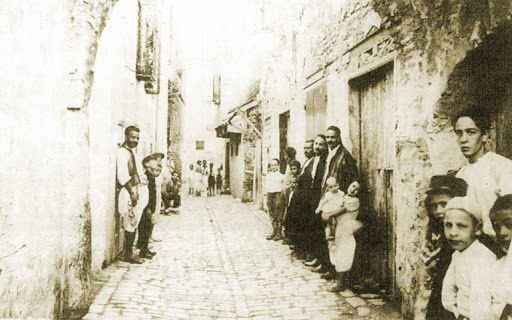
(The Hara of Tunis, image #1)
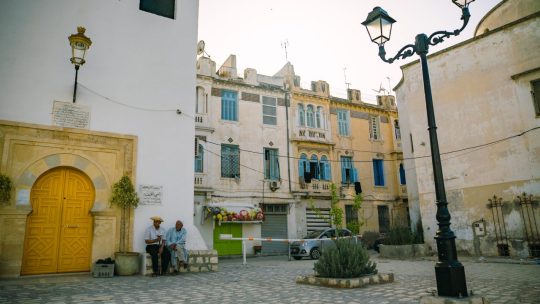
(The Hara of Tunis, image #2)
The French Colonization, starting in the late nineteenth century, created a new elite of Francophones. The upper Jewish class eagerly fostered French as their mother tongue, named their children in French names and sent their children to schools in Paris. The few, who managed to obtain key posts in the new colonial governments, were granted French citizenship, but the majority including some of the wealthiest families remained with the status of subjects.

(The French Quarter of Tunis)
Despite the strong French influence, Tunisia continued to be fairly diverse as a port country luring people from different parts of the Mediterranean basin. Thus, the Jewish population (unlike their brothers in neighboring Algeria) lived in a multicultural environment, in which Greeks, Maltese, Italians and of course Arabs co-existed and influenced one another.
A Boy in a Ruthless City: The Nazi Occupation through the Eyes of an Adolecent
The cosmopolitan climate described above was the setting of Albert Memmi’s (1920-2020) semi-autobiographical novel, The Pillar of Salt. In the book, Memmi, a distinguished philosopher known for his work on Colonial Studies, disguised himself as Alexandre Mordekhai Bennillouche, a poor Jewish boy growing up in the Hara of the capital, Tunis.

( Albert Memmi)
Bennillouche (or Memmi) begins his account in describing his happy childhood as an age of innocence and unawareness to his poverty and inferior status as a “native Jew”. Gradually, the protagonist discovers the world around him. He excels at school, but suffers from anti-Jewish violence from Chirsitan and Muslim peers. Given his academic performance, he is given a stipend to study in one of the city’s top schools, where he is introduced to the upper circles of the Jewish community and the general European society. This exposure causes a rift in the relationship with his parents, who resent his education wishing for him to continue the family leather business. Although deeply ashamed of his parents - their meager existence and traditional views- Bennillouche is quickly disillusioned from the enchantment of the elite. Being a critical thinker, he spots its insincerity and snobbery, yet he is forced to hide his contempt as he is dependent on their funds for his schooling.

(The capital- Tunis)
The six month Nazi occupation of Tunisia (November 1942- May 1943) reaffirms Bennillouche’s beliefs about the hypocrisy of the elite. During the short- yet traumatic - German presence, Tunisian Jews were subject to constant harassment from the occupiers and general population, and were under the imminent threat of being deported to the death camps in Europe. Yet, the degree of Jewish misery varied based on socio-economic belonging. When the Germans issued a decree for Jewish forced labor, the wealthy ones of the community paid ransom to exempt themselves and their dear ones. Impoverished men- however- were destined to greater hardship.
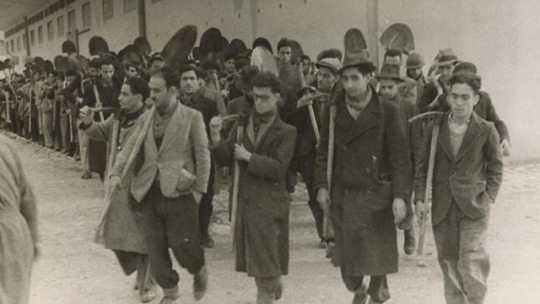
(Jews assigned for forced labor)
Benillouche (and Memmi himself) was one of the unfortunate people. Despite being friendly with people in high places, and holding a prestigious teaching position, he was deported to a concentration camp in the Saharan desert. There, he suffered from the brutality of the guards, the senseless work, and above all the merciless sun. However, camp was also a place of revelation. The hardship created a sense of comradery between Benillouche and his fellow inmates, of whom he shared similar upbringing. He was even reunited with some old friends, and enjoyed conversing with them in his childhood dialect of Judeo- Arabic, which he neglected in favor of French. In addition, the camp helped him to rediscover and reconnect to his Jewish roots, as he was asked to lead Shabbat prayers as the camp’s intellectual figure.
By the time the camp was released by the Allies, Bennilouche was a more grounded man. He still continued to march according to his original trajectory in the academic world but with a wiser outlook on life.
Topped with Harissa: A Quick Peek to Jewish-Tunisian Cuisine
Even while estranged from his family traditions, Bennilouche always maintained a fondness for his mom’s traditional Tunisian cooking. In fact, he recounts nostalgically the smells of Shabbat dishes cooking slowly in the tiny kitchen of his childhood home. When he matures, he recognizes the power of food as a source of comfort and festivity in a household that is poor and filthy. One of the dishes he highlights is Bkeila (also pronounced Pkeila) - a hearty spinach and beans stew served vegetarian or with beef. Below is Yotam Ottolenghi’s take on it from his latest cookbook Flavor.
Bkeila, Potato and Butter bean Stew - Adapted from Flavor
(See my notes below to simplify the cooking process)
4 cups (80 gram), roughly chopped cilantro
1 ½ cups (30 gram) parsley
14 cups (600 gram) spinach
½ cup (120 ml) olive oil
1 onion (150 gram), finely chopped
5 garlic cloves, crushed
2 green chiles, finely chopped and seeded
1 tbsp plus 1 tsp ground cumin
1 tbsp ground coriander
¾ tsp ground cinnamon
1 ½ tsp superfine sugar
2 lemons: juice to get 2 tbsp and cut the remainder into wedges
1 qt/ 1L vegetable/ chicken stock
Table salt
1 Ib 2 oz/ 500 gram waxy potatoes, peeled and cut into 1 ¼ inch pieces
1 Ib 9 oz/ 700 gram jar or can of butter beans, drained
1.In batches, put cilantro, parsley and spinach in a food processor until finely chopped. Set aside.


(Massive amounts of greens)
2.Put 5 tbsp of olive oil into a large heavy-bottomed pot on medium heat. Add the onion and fry until soft and golden, mixing occasionally (about 8 minutes). Add garlic, chillies and all the spices and cook for another 6 minutes, stirring often.
3.Increase the heat to high and add the chopped herbs and spinach to the pot along with the remaining 3 tbsp olive oil. Cook for 10 minutes, stirring occasionally until the spinach turns a dark green. The spinach should turn a little fried brown but not burn. Stir in the sugar, lemon juice, stalk and 2 tsp salt. Scrape the bottom of the pot if needed. Bring to a simmer, then decrease heat to medium and add the potatoes. Cook until they are soft for about 20-25 minutes and then add the butter beans and cook 5 minutes longer.*

(Butter beans to break the deep green)
4.Divide into bowls and serve with lemon wedges.**
* As this dish was traditionally slow cooked using a slow cooker pot or a pressure cooker could easily do the trick. If using these- do the following: Skip step 1. Saute the onions, garlic, chilli and species as instructed in step 2. Then add the rinsed spinach and herbs. Mix them well with the onions and spices in the bottom. Once the spinach begins to melt, mash them using a hand blender and then add the ingredients described in step 3 (beside the butter beans). Then let it slowly cook until everything softens. In the end, add the butter beans and press on the “stay warm” button.

(loading the pot with spinach)
** I served it with bulgur to soak up the liquids a bit (rice, farro or any other grain will work as well). I also added hard boiled eggs for additional protein.

(Healthy and heart)
In addition to the Bkeila- The Tunisian Shabbat table will not be complete without the famous couscous. The process of making it from scratch without a food processor was quite laborious, but the result - whether served sweet with nuts and spices, or savory with meat stew or fish - was considered a delicacy.
The proximity to the Mediterranean shore brought fish dishes to the Jewish- Tunisian repertoire. Fish is mostly eaten fried or cooked as fish balls or oven roasted served with red hot sauce. Meat is also often served spicy, and often chunks of hot merguez sausage are added to stews or shakshuka.
Generally speaking, Tunisian Jews are fond of hot flavors, and their cuisine is potentially the spiciest in the diaspora (perhaps only second to the Yemeni). Harissa paste, now increasingly popular around the world - is liberally used to spice up any dish. This fiery red pepper condiment is added - for example- to the famous Tunisian fricassee, one of Israel's most popular street foods. Click here for a recipe for this tuna loaded sandwich, and here to learn more broadly about Tunisian cuisine.

(Tunisian Sandwich with some Harissa)
8 notes
·
View notes
Text
DAWN IN THE SUNFLOWER
dawn in the sunflower rose garden 3
memmy's song
a parker-ology poltergeist picture of perfection planned probably on paper 📜 but translated in computer code 🖥️ on tomes of parchment in sunday issues of gazettes in Moscow.
satan and me dancing in a tree
I see medusa, she's such a loser but her hair is beautiful
it's like fire
I'm like water on a lake
water's on the way
anyway I can get it that's the way I
want it want it want it
murder on the beach
on the waves
coming off the sea
hopefully I don't leave
hopefully I'm undone like my niece
like me?
I love you
why me?
what a lovely view
my ugly shoes are missing strings
she's eating string beans and saying please
hope I don't sneeze
kicking old leaves
leaving notebooks in the hallway
leaving detention all day
left outside one night, met some guy
didn't say his name so I
figured it out by 9 the next morning
but I decided his name should rhyme so instead of ed I said I bet it's better than a million little stars in heaven when - and then - he sang a song real long...
so all night I cried
he died
I lied
we fly like peacocks in jet planes!
PARKER THOMAS MENN
0 notes
Photo

Hello dear people,
Today ,I am going to share with you one of my favourite buildings I have ever visited. It is so special for me as I was born in the city where this tower is built.
The photo was taken by me on 26th November 2019 during my trip in Italy which lasted 3 days.
Below you are going to find a piece of information about this magnificent tower. If you are planning to visit Tuscany ,I suggest you city of Siena. It is a quiet city ,full of culture,history and... delicious italian food. Twice a year, there is held a horse race “Palio di Siena”.
Torre del Mangia (Tower of the Eater)
is a magnificent tower in the Tuscan city of Siena, Italy. The tower took a whole decade to be constructed and became the stronghold of many governors in its time. It was built between the years of 1338 and 1348. The place holds a scenic charm to it, which adds to the city’s magnificent architecture and is situated in Piazza del Campo (Campo Square).
The tower was built to rival the tallest tower in all of Florence. It was the tallest tower of its time, with a height of 88 meters. Currently it is the third tallest tower in all of Italy. Torre del Mangia, the name which was given to this tower, was derived from the nick name of its guardian; Giovanni di Balduccio. Giovanni was nick named Mangiaguadagni.
The upper structure of the tower was designed and structured by Lippo Memmi; a famous architect, in his time. Cappella di Piazza (Cappella square) was made part of the tower in 1352, after the infamous Black Death epidemic. The survivors built it as a vow for the holy virgin. Mariano d’Angelo Romanelli and Bartolomeo di Tommé designed the sculptures which decorate the entrance to the tower.
In 1360, a mechanical clock was fitted in the wall of the tower, along with three bells at the highest point within the tower. The greatest of the three bells has been given the name “Sunto”.
The loggia; which are the sculptures present at the tower’s entrance, used to be covered by a simple ceiling. It was later turned into an elaborately designed Renaissance marble vault, stunning in its architecture. This vault was constructed during the years 1461-1468. The order of their construction was given by Antonio Federighi.
It was built to match the height of Duomo di Siena (Siena Cathedral) to signify that the church and the state were equal in prowess and held the same level of authority. Its walls are 3 meters wide and have been designed with intricate precision.
Bordering the tower is the Palazzo Pubblico (Public Palace), whose Gothic architectural style and design, has become the inspiration of many people. A fresco was painted over the Altar in later years, which was then moved into the Palazzo Pubblico.
The tower can be seen from all parts of Siena, no matter where you might be standing. Once you reach the highest pinnacle of the tower, you can enjoy beautiful scenery and views of the surrounding countryside.
So whenever you make plans to visit Siena, make sure to check out Torre del Mangia and Palazzo Pubblico; gorgeous places with interesting design and strong historical backgrounds.
1 note
·
View note
Photo

Occupying our number 3 of #PostcardAfrica is another North African country called Tunisia. Its accessible Mediterranean Sea coastline and strategic location have attracted conquerors and visitors throughout the ages, and its ready access to the Sahara Desert has brought its people into contact with the inhabitants of the African interior. Tunisians are renowned for their conviviality and easygoing approach to daily life, qualities that Albert Memmi captured in his 1955 autobiographical novel, Pillar of Salt. This warmth joined with the country's renowned hospitality and cuisine has contributed immensely to Tunisia's growing popularity as a destination for tourists from throughout Europe and the Americas. #beach #sun #nature #water #TFLers #ocean #lake #photooftheday #beautiful #sky #clouds #cloudporn #fun #sand #reflection #amazing #beauty #beautiful #shore #waterfoam #seashore #waves #wave #tunisia #tunis #pillarofsalt #sahara #mediterranean #hotels https://www.instagram.com/p/B5fpTulnZ0_/?igshid=148qm8rshuqjb
#postcardafrica#beach#sun#nature#water#tflers#ocean#lake#photooftheday#beautiful#sky#clouds#cloudporn#fun#sand#reflection#amazing#beauty#shore#waterfoam#seashore#waves#wave#tunisia#tunis#pillarofsalt#sahara#mediterranean#hotels
0 notes
Text
I forgot to post this after I finished it (even tho it was 3am when I did)
But here is Memory (alter) as he was growing up :3

(text in corner + beside 10yrs old Memmy)
6hrs old- smaller than average
3yrs old- taller than average/normal
10yrs old- mini Void + finding style (has one of Void's old ties)
15yrs old- chubby + muscular
21yrs old- idk but dayum 😍
40yrs+ - current
Some fun notes I can add cus Tumblr has basically an unlimited character amount:
Memmy has a beauty mark under the corner of his left eye, that at certain angles and distances, it looks like long eyelashes or eyeliner
In every age except 21 and above, Memory had a spirally piece of hair that later became less noticeable as it now follows his natural hair. When first created, he was originally gonna be named "Spiral Steve" by Void due to it, but later decided to wait for his powers to develop before setting a name in stone. Spiral is now Memory's middle name (for the Steve species I guess). His full name is Memory 'Spiral' Steve/NoirNova
His hair is naturally very curly, but he prefers to keep it straightened, as it looks less tangled when he has his hair down since it goes past his tail bone and to his knees. He also had some small freckles that faded over time
When Memory was finding his style at the age of 10, he found one of Void's old ties and asked Void for help putting it on. Memory at the time didn't like the feel of it around his neck, so he just had it kind of hanging down. Memory later got a bunch of Voids old ties (and suits) and now has them as his own. Void got very emotional when Memory was growing up and found a love for suit and ties, as while Memory still had yet to learn manners (for a 10, year old), he still had a lively and playful spirit.
Memory at 15, once becoming something of a young adult and growing more mature, he gained a small bit of weight. It didn't bother him and he just continued to work out normally for fun/to relax. He also slightly started growing his beard a bit.
Around being 15 is also when Memory gained a few permanent scars from a fight he doesn't like talking about, the most visible one being on his right cheek. (no, it was not against Void. It'd unintentionally be the opposite between them, as Memory has more muscle strength and agility than Void, and Void is slightly scared of it since Memory can cause a cave in with a singular kick [it does not hurt him])
At 21 he had a small change in appearance. One side of his hair was a side swept cut with the other side being shaved into a swirl. (A style similar to Venus McFlytrap from Monster High) and had eyeliner and a piercing near his lip on the right side. Along with wearing a suit vest instead of his current suit jacket. He also tried wine for the first time, and settled on red wine being his favorite
Around maybe his late 30's and going into his early 40's Memory later ditched the style he had, and became the current one he has now. His classic suit and tie, and hair in a specific ponytail to keep it shortened
9 notes
·
View notes
Text
Five Benefits Of Famous Art Paintings That May Change Your Perspective | Famous Art Paintings
Original painting: Gustav Klimt, “The Kiss,” 1907
Art history is accepting a Disney makeover in a new alternation of ilrations by artisan Carlos Gromo. These artistic renditions abode characters from activated affection films into acclaimed works of art, such as Gustav Klimt’s The Kiss and Grant Wood’s American Gothic.
The Spanish artisan began the alternation in 2019 as a way to accomplish clical paintings added agreeable for bodies who are not accustomed with art history. Gromo redraws the compositions of iconic masterpieces and substitutes the capacity with Disney characters that fit with the theme. What makes anniversary of his ilrations so absorbing is how he seamlessly blends Disney’s iconic appearance into the design. Gromo includes a baby thumbnail of the aboriginal afflatus in the bend of anniversary allotment so admirers can see the transformation.
Some of his reimaginings fit all too well. For instance, Gromo combines Henry Meynell Rheam’s The Fairy Wood with the casting of Snow White. In this busy composition, the raven-haired angel strolls through the backwoods in an ivory gown, as the seven dwarves advice backpack the alternation of her cape. In the background, the prince can be spotted benumbed his white horse in Snow White’s direction. Likewise, Ariel and Prince Eric from The Little Mermaid are abundantly placed into John William Waterhouse’s painting The Siren, in which Eric acquiescently gazes up at Ariel arena a harp on a rock.
You can acquirement prints, keychains, and added artwork on Gromo’s Etsy shop, and see added Disney-inspired artwork by afterward the artisan on Instagram.
Five Benefits Of Famous Art Paintings That May Change Your Perspective | Famous Art Paintings – famous art paintings | Delightful to be able to the website, in this moment I will explain to you in relation to keyword. And from now on, this can be a 1st image:
Transform Your Selfies, Pet Portraits Into Famous Artworks | Smart .. | famous art paintings
Why don’t you consider impression previously mentioned? is which wonderful???. if you think consequently, I’l d show you several image again down below:
So, if you wish to receive all these amazing photos about (Five Benefits Of Famous Art Paintings That May Change Your Perspective | Famous Art Paintings), just click save link to store these pictures in your laptop. There’re prepared for download, if you’d rather and want to obtain it, simply click save logo in the article, and it will be instantly saved in your notebook computer.} Finally if you desire to have new and recent picture related to (Five Benefits Of Famous Art Paintings That May Change Your Perspective | Famous Art Paintings), please follow us on google plus or book mark this blog, we try our best to offer you daily update with all new and fresh graphics. Hope you like staying here. For many updates and recent news about (Five Benefits Of Famous Art Paintings That May Change Your Perspective | Famous Art Paintings) images, please kindly follow us on twitter, path, Instagram and google plus, or you mark this page on book mark section, We try to provide you with up-date periodically with fresh and new graphics, enjoy your searching, and find the best for you.
Thanks for visiting our site, contentabove (Five Benefits Of Famous Art Paintings That May Change Your Perspective | Famous Art Paintings) published . Today we’re pleased to announce we have discovered an incrediblyinteresting nicheto be reviewed, namely (Five Benefits Of Famous Art Paintings That May Change Your Perspective | Famous Art Paintings) Many individuals attempting to find details about(Five Benefits Of Famous Art Paintings That May Change Your Perspective | Famous Art Paintings) and definitely one of them is you, is not it?
What were the first paintings by famous artists? – famous art paintings | famous art paintings
Wieco Art The Scream by Edward Munch Famous Paintings Reproduction Abstract Canvas Prints Artwork for Wall Decor Modern Canvas Wall Art for Home & .. | famous art paintings
Details about FAMOUS PAINTINGS AND FINE ARTS ON DVD 18+ IMAGES – famous art paintings | famous art paintings
The Scream | Art, Famous art, Paintings famous – famous art paintings | famous art paintings
PAYING A VISIT 3 — PALETTE KNIFE Oil Painting On Canvas By .. | famous art paintings
Famous Art Oil Paintings By Indian Artists By Van Gogh – Buy Oil .. | famous art paintings
Top 18 the most famous abstract art paintings in the world – famous art paintings | famous art paintings
Artist Reimagined Famous Paintings To See What They’d Look Like If .. | famous art paintings
Paranoia Of Matter – famous art paintings | famous art paintings
Top 18 the most famous art painting abstract in the world – famous art paintings | famous art paintings
Famous Food Paintings in Art History | Fine Art Blogger – famous art paintings | famous art paintings
Leonid Afremov, oil on canvas, palette knife, buy original .. | famous art paintings
Famous Art Reinterpretations : recreates famous paintings – famous art paintings | famous art paintings
Leonid Afremov, oil on canvas, palette knife, buy original .. | famous art paintings
Artist Gives Famous Paintings Geeky Cartoon Makeovers | HuffPost – famous art paintings | famous art paintings
Art in Detail:Famous Paintings of Angels – famous art paintings | famous art paintings
La preghiera nell’orto degli ulivi – fratelli Lippo e Federico Memmi ciclo di affreschi con Storie del Nuovo Testamento,dipinti tra il 1338 e il 1340 – famous art paintings | famous art paintings
from WordPress https://www.bleumultimedia.com/five-benefits-of-famous-art-paintings-that-may-change-your-perspective-famous-art-paintings/
0 notes
Text
Camp NOLA
In accordance with a family tradition that appears to have formed over the last 3-4 years, I took the kids on our annual weeklong trip to my beloved hometown of New Orleans last week. The last few years, I’ve found myself running there every 2nd week of August, in that summertime Black Hole period between the end of the kids’ school-based summer camp, and the start of the new school year. A week at Ajima and Thatha’s house has become its own little summer camp to our crew: Camp NOLA :)
This year, I’d be flying there on my own with the two kids, while Dr. Spouse stayed back to complete an on-call week before flying out for the second weekend. My first experience flying solo with the crazies was on our first official Camp NOLA week in 2015, which I blogged about here - that time we traveled earlier in the summer, between the school year’s end and the start of summer camp. But same basic idea. Anyway, since that first brave voyage, I’ve traveled a shitload of times with both kids on my own, and I like to think I’m kind of an old pro at it by now. It’s gotten significantly easier, in many ways, now that both kids are independently mobile and fairly reliable walking and holding hands in crowded airports, managing security checks expertly, and all that - just earlier this year, we started traveling without a stroller, and it was like the heavens parted and rays of light streamed down around me from the heavens. Oh, to have the freedom to breeze through security without having to disassemble a stroller and manage all the stuff, only to put it all back together on the other side of the metal detector! To skip, hop, and sashay directly into the aircraft from the jet bridge, without having to unstrap the kids, bark at them to stand aside so other people can pass while I sweat and heave and disassemble the thing for the cargo hold! Life has changed.
The kids are pretty good fliers, but certain people (ahem, DEY) are still a little bit rambunctious and animated in the airplane.... sigh.

Time spent at my parents’ house is always fun for the kids. Vev frequently, and in great descriptive detail, talks about all the reasons why he likes my parents’ house better than our own. I am simultaneously touched and miffed by his honesty. But I know why it is they love the place. Aside from the obvious, awesome thing that my parents’ house has going for it - MY PARENTS - the kids also just love to sort through all the random crap that they have, most of which dates back to my own childhood. My pack rat parents have thrown very little away when it comes to my old toys, books, and childhood accoutrement, and this delights the kids to no end.
Take, for example, Vev’s infatuation with my Lego cargo airplane set, which I probably acquired when I was around 8 years old, and managed to preserve in its box still fully assembled (thank god - b/c I likely wouldn’t be able to put it together now!)

Dey had a great time building and demolishing and rebuilding a hospital from one of my sister’s Lego sets:
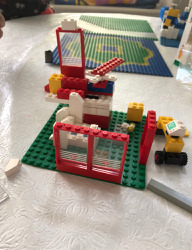
Another relic of my childhood, which Vev enjoyed creeping me out with on the daily: my childhood rocking chair, which still lives in my bedroom (this is despite the fact that I didn’t not actually grow up in the house where my parents currently live; clearly, they never got rid of the chair, despite them having moved 2 times since I was a kid, the last time when I was in my 20′s). The chair is the perfect size for Vev, and every morning, early in the wee hours, I’d open my bleary eyes, and immediately see this:

Such a creeper, that kid.
My dad, in his perpetual hyperness, did a generous (and kind of crazy) thing, and sprung for two expensive mountain bikes for the kids. I was kind of bewildered that he’d done that, when they’re going to outgrow these bike sizes so fast, and there’s also no easy way for us to transport the bikes back here to Florida... but, he’s an excited grandfather, so I guess he exercised his prerogative to spoil his grandkids rotten. The kids honestly LOVED their bikes, and went on twice-daily bike rides in the neighborhood park.
Dey had actually never ridden a bike prior to this, and he rapidly gained skill in it over the week - although he picked up the skill of speed far quicker and more easily than he has the skill of steering. It’s a nerve-wracking situation. Oh, and he refused to wear a helmet. So, yeah - he’s all over the place.

One of the kids’ favorite things about stays at Ajima’s house are the relaxed sleeping arrangements and bedtime routine... which is to say, there really wasn’t one. They were staying up waaaaay past their normal bedtimes at home, and sleeping either with each other or with me in my bed. Sleep deprivation and bad sleep hygiene are hallmarks of our summer NOLA getaways. They didn’t really seem to be affected by this, but I was fucking exhausted the entire stay.

NOLA means beignets!!!!! Hurray for fried carbs and mountains of sugar!!!


This NOLA trip was even more special than usual, because my uncle A and aunt N (father’s youngest brother and his wife) were visiting my parents from India, so we got to catch up with them and spend lots of quality time. It was also wonderful to have not one, but TWO Ajimas and Thathas around the house for child entertainment, conversation, and feeding. Glorious! We spent a few evenings of their stay going through some old home videos that my mom recently had converted to DVD. The stills below are from a 1994 trip to India that my family took to spend time with relatives. The weird looking preteen in the awkward head scarf and navy striped get-up is yours truly :) And the lady in the green sari is my paternal grandmother, Rajalakshmi (nickname Mani). We lost her very suddenly and heartbreakingly in May 2002, and none of us have quite gotten over how she was yanked out of our lives... it was poignant but wonderful to see her again on film, looking so animated and full of life. My dad and uncle sat in silence, watching these videos for hours.....


After about six days of being relative homebodys, playing with tons of old but dear toys, hanging out wth Ajima, Thatha, Thatha A and Ajima N, Thursday rolled around and Dr. Spouse arrived. The kids were happy to see Daddy, and his arrival signaled the chance for us to go out, do some excursions and sightseeing, and visit with friends.
Annual trip to the Riverwalk - a shopping and entertainment plaza along the Mississippi River, affording lots of chances to watch boats and freighters go by...

Dinner out at a Creole restaurant, where clearly our eyes were waaaay bigger than our stomachs!

Something I’ve wanted to do for a super long time - maybe 2-3 years - is to take the kids to a local small, organic farm near my folks’ house called Sugar Roots Farm. They have open community days on Saturdays, and somehow on our annual trips, we’ve managed to not spend full Saturdays in town, and thus haven’t been able to visit. But this time, we did - and we got some hands-on learning about sustainable farming, farm-to-table food production, and of course, animals!

This place is literally behind my parents’ house - its so weird!

Excited to see a tractor.... our main frame of reference with tractors are the ones that get cow-tipped in the Disney Pixar movie “Cars.”

Horses were intimidating.

Ponies were more up the alley of certain people.

We bought feed cups for a dollar so we could make friends with the goats, sheep, alpacas, and chickens.... but in the end, apparently my lionhearted sons were terrified of the teeth on most of these animals, so I got to feed them myself, haha :)

Feeding chickens was manageable, I guess.


Dey’s reaction to the rabbits was hilarious. He ran over to this enclosure, spotted a large white rabbit hopping around, immediately turned around making this face and exclaimed “Look, a bunny! It’s a bunny! It’s a GIRL!!!!” then just ran off again. Uh, what? Why do you assume its a girl?!!! It was so weird!!!

A GIANT pig. A very sleepy giant pig.

Quack quack quack.

Daddice with the boys.

This was an enjoyable way to spend an hour and change one morning!
Later that same day, we took a VERY special day trip to Baton Rouge, to the home of my cousin and bestie, Neets. She and her hubby B have two daughters, S and M, and they just put a new swimming pool in the yard of the home they’ve lived in for the last 2 years. We were excited to have a swimming playdate together, so I picked up a special gift for the girls which was immediately put to use: a giant inflatable rainbow cloud. Cousin bonding time!


I absolutely love this woman <3
Our final evening in New Orleans was spent playing tourist in my hometown. Ajima and Thatha accompanied us on a mule carriage tour of the French Quarter, where Bonnie the Mule and her driver/guide regaled us on the super-interesting history of the city. It was a throwback to my elementary and middle school History classes and field trips, where we’d tour historic sites and antebellum homes, write essays and field trip reports and special projects about Louisiana history and the mixed Creole, French, Spanish, and American culture of New Orleans.

Our attempt to recreate one of our iconic wedding pictures.... unfortunately the, er, large gentleman in the background decided to join us for the fun.


Updated family version.... how far we’ve come.
All too soon, it was time to bid goodbye to Ajima and Thatha, and to our delightful Camp NOLA. And now we’re back to Camp Memmy in our Miami home.... which is significantly less exciting for everyone involved!!!
0 notes